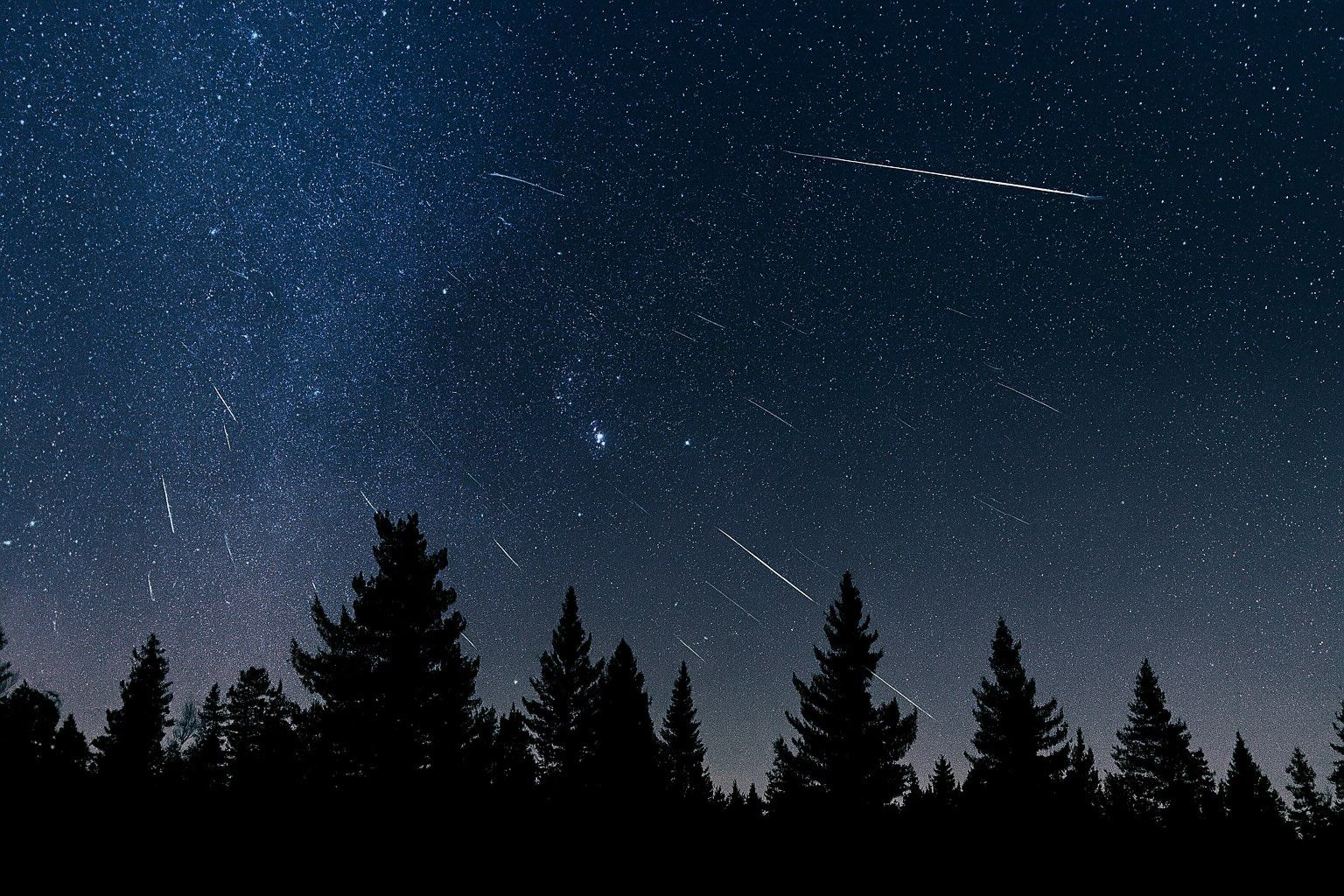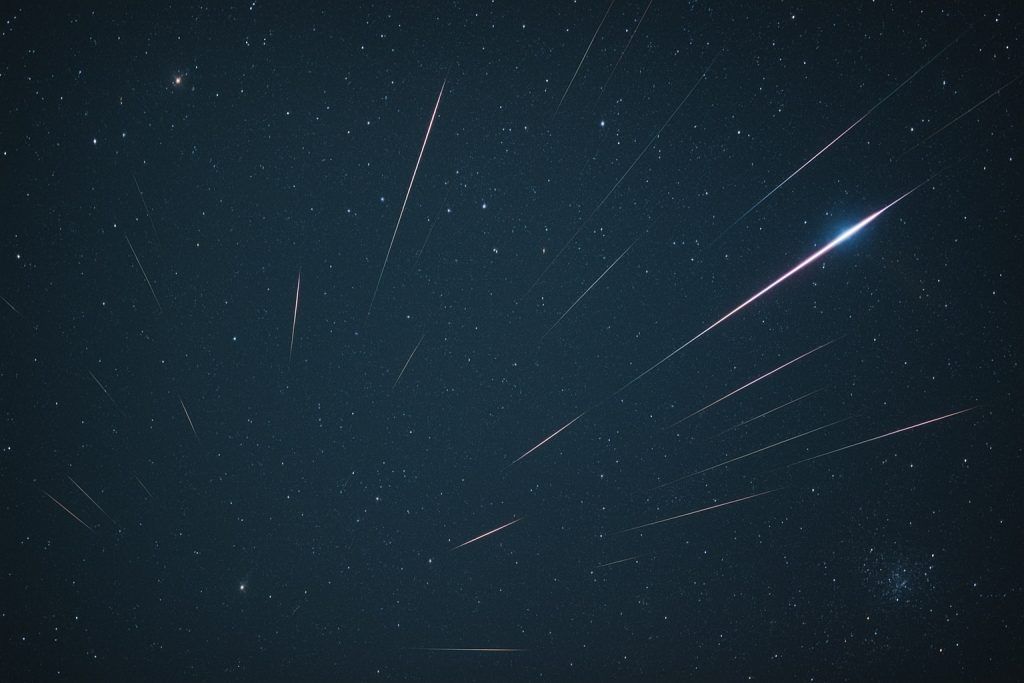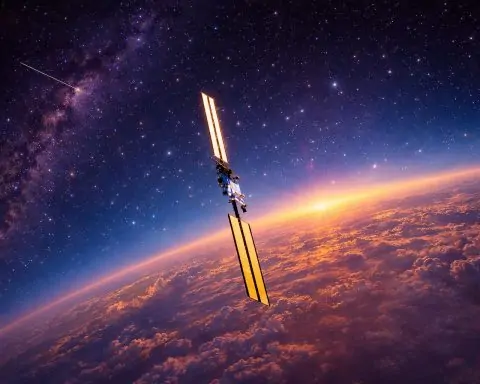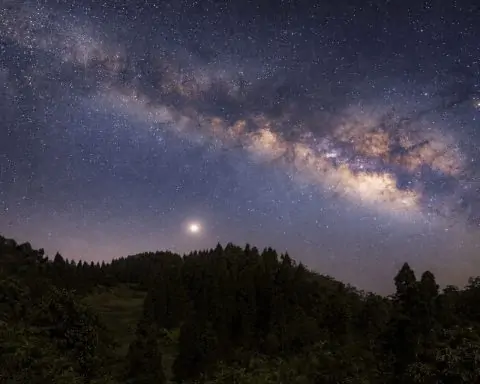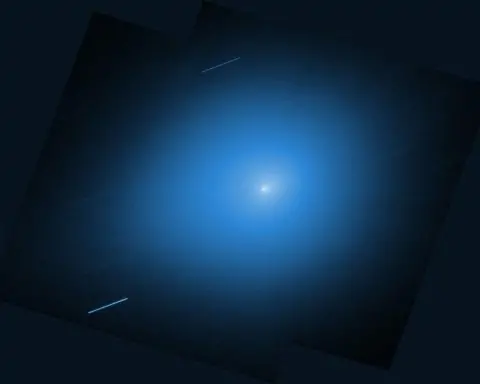- The Geminid meteor shower peaks overnight on December 13–14, 2025, with as many as 100–150 meteors per hour under dark skies, originating from asteroid 3200 Phaethon.
- The Ursid meteor shower peaks around December 21–22, 2025, near 11:00 UTC, typically producing 5–10 meteors per hour under dark skies thanks to a new Moon on December 20.
- Mercury reaches its greatest western elongation on December 7, 2025, about 20° west of the Sun, with magnitude around −0.5 and visible low in the southeastern dawn sky about 30–45 minutes before sunrise.
- On December 7, 2025, a Moon–Jupiter conjunction occurs with a Moon about 89% lit near Jupiter in Gemini (magnitude around −2.6) after dusk.
- Saturn’s rings appear nearly edge-on in late 2025, making the rings almost invisible with Saturn at magnitude +1.0 in Aquarius, and a crescent Moon (about 31% illuminated) will pass near Saturn on December 27.
- The December solstice occurs on December 21, 2025 at 15:03 UTC, marking the start of winter in the Northern Hemisphere and summer in the Southern Hemisphere.
- The Full Cold Moon on December 4, 2025 at 23:14 GMT is a Supermoon roughly 7.9% larger and 15% brighter than an average full moon, due to near-perigee.
- December 2025 has no eclipses, with the previous total lunar eclipse in September 2025 and the next total lunar eclipse not until March 2026.
- Solar maximum activity is ongoing in December 2025 as part of Solar Cycle 25, increasing sunspots and solar flares and raising the likelihood of auroras at high latitudes and occasionally mid-latitudes.
- To maximize December 2025 observing, plan around Geminids after 9–10 p.m. local time, seek dark skies away from city lights, and use a stargazing app to time rises and sets.
December 2025 is shaping up to be a celestial extravaganza. From one of the year’s most spectacular meteor showers under dark, moonless skies to unusual planetary alignments and the heightened chance of dazzling auroras, skywatchers around the world have plenty to look forward to. This public guide breaks down the month’s major astronomical events – including when and where to see meteor showers like the Geminids, notable planetary meet-ups, the December solstice, and even potential northern lights displays – with expert commentary and tips on how to observe each phenomenon. Get ready to mark your calendars and bundle up for some late-night stargazing adventures!
Meteor Shower Spectacle: Geminids & Ursids Peak Under Dark Skies
The Geminid meteor shower – often considered the strongest annual meteor display – will be the headline event of December 2025. The Geminids are expected to peak overnight on December 13–14, when Earth passes through the dense debris trail of asteroid 3200 Phaethon [1]. Under ideal dark-sky conditions, observers could see as many as 100–150 “shooting stars” per hour at the peak [2] [3]. “The Geminids are usually the strongest meteor shower of the year, and meteor enthusiasts are certain to circle December 13 and 14 on their calendars,” notes the American Meteor Society [4]. Luckily, this year offers near-perfect viewing conditions – the shower’s peak falls just a few days after the last quarter moon, so only a faint waning crescent will rise in the early morning hours, providing a mostly moonless night for meteor hunting [5] [6]. According to NASA meteor expert Bill Cooke, the Geminid shower has even been getting stronger over the centuries “because Jupiter’s gravity has tugged the stream of particles from [Phaethon] closer to Earth” over time [7]. The Geminids’ meteors tend to be bright, white, and slower-moving than Perseid meteors, making them easier to spot and enjoy [8].
How to see the Geminids: The meteor activity will ramp up on the nights surrounding the peak, so you can start watching on December 12 or continue on the 14th if skies are cloudy on the peak night [9]. No telescopes or binoculars are needed – in fact, it’s best to use just your eyes to catch the flash of meteors across a wide sky. Plan to head to the darkest location you can find, away from city lights, and give your eyes at least 20–30 minutes to adjust to the darkness. The Geminids’ radiant (the point in the sky from which meteors appear to originate) is in the constellation Gemini, which rises in mid-evening in December. That means you can start looking for meteors by around 9–10 p.m. local time once Gemini is above the horizon [10] – a rarity among meteor showers, many of which are best after midnight. For viewers in the Northern Hemisphere, Gemini rises higher overhead and earlier in the night, so Geminid meteors may be seen all night long, with rates peaking in the wee hours around 2 a.m. [11]. In the Southern Hemisphere, Gemini appears lower in the sky; you may need to wait until around midnight for the radiant to climb above the horizon, but patient observers could still catch a decent display (at lower rates) in the pre-dawn hours [12]. Dress warmly, bring a reclining chair or blanket to lie back on, and scan the sky – meteors can streak anywhere, though tracing their path backward should point to Gemini. With the crescent moon setting early, 2025’s Geminids should put on an excellent show, weather permitting [13] [14].
Just after the Geminids, the modest Ursid meteor shower offers a bonus sprinkle of shooting stars around the December solstice. The Ursids peak on the night of December 21–22 (around December 22 at 11:00 UTC by predictions) [15]. This minor shower, arising from dust left by comet 8P/Tuttle, typically produces only around 5–10 meteors per hour at best [16]. However, 2025 is an especially favorable year for Ursid-watching because a new moon occurs on December 20, meaning dark skies during the peak nights [17] [18]. “This low-key meteor shower – which always peaks around the solstice – is somewhat overlooked due to the holiday season,” the editors of EarthSky note, but in 2025 you’ll have dark skies all night and “the Ursids are worth a look!” [19]. The Ursid meteors fan out from the constellation Ursa Minor (the Little Dipper), near the North Star, so the Northern Hemisphere is the place to see them – the radiant is circumpolar (never sets) for most northerly locations [20] [21]. Unfortunately this means Southern Hemisphere observers won’t see much from the Ursids, as Ursa Minor never rises for them [22].
How to see the Ursids: If you’re in mid-northern latitudes, try watching for Ursid meteors starting late on December 21 through the predawn of December 22. With no moon to interfere and the Ursid radiant circling near Polaris, you can potentially catch the shower all night (although peak rates are low) [23] [24]. Find a dark spot and face north if possible, keeping an eye on the sky around Ursa Minor. Although the Ursids won’t match the Geminids’ intensity – think of it as a gentle “meteor sprinkle” – you might see a few surprising streaks. And who knows, meteor showers can sometimes surprise us. The Ursids have occasionally produced outbursts in the past, so it’s worth checking if any last-minute predictions arise. At the very least, it’s a fun opportunity for dedicated skywatchers to extend the meteor season into the holidays while enjoying the calm of the solstice night.
Planetary Encounters and Rare Alignments
The planets will offer some delightful alignments in December 2025, including chances to spot elusive Mercury at dawn and a “ringless” Saturn at dusk. Early in the month, Mercury reaches its greatest western elongation on December 7. On that date, Mercury will be at its farthest apparent distance west of the Sun (about 20° away) in the morning sky [25]. This is the best opportunity to observe Mercury for the remainder of the year. The innermost planet shines around magnitude –0.5, so it should be visible as a modest but clear point of light low in the southeastern sky before sunrise [26]. Don’t miss the chance to spot Mercury, as it never strays far from the Sun’s glare; you’ll need to wake up during twilight (about 30–45 minutes before local sunrise) and have an unobstructed view of the horizon [27]. Observers in tropical and southern hemisphere locales may have a slightly higher Mercury in the sky due to the angle of the ecliptic, but everyone should use binoculars carefully (only before the Sun rises) if needed to pick Mercury out of the dawn glow. Once you find it, see if you can follow Mercury with the naked eye – catching this tiny world is a special treat that many casual observers have never experienced.
Skywatchers will also be treated to a beautiful pairing of the Moon and Jupiter on the evening of December 7. On that night, a waxing gibbous Moon (~89% lit) will glide just a few degrees from bright Jupiter in the constellation Gemini [28]. The Moon–Jupiter conjunction will be an eye-catching sight – Jupiter, shining around magnitude –2.6, outshines every star in the night sky [29]. Look toward the east after dusk on December 7 and you’ll see the brilliant Jupiter near the nearly full Moon. They’ll be closest in the late afternoon (around 15:48 GMT) when below the horizon for the Americas [30], but for most locations on the night of Dec 7, the two will still appear only a few finger-widths apart. No telescope is needed to enjoy this celestial meetup, though binoculars will reveal Jupiter’s disk and perhaps some of its moons even against the moonlit sky. (Fun fact: that bright “star” next to the Moon is not a star at all, but the largest planet in our solar system!). This conjunction is a great chance to point out Jupiter to friends or kids who might mistake it for an airplane or star. Enjoy the sight as the duo arcs across the sky and note that just two nights later, on Dec 9, the Moon will move on to occult the bright star Regulus in Leo in some parts of the world [31] – the sky is always in motion!
Saturn, meanwhile, is putting on a very unusual show in late 2025: its rings have virtually vanished from view. Don’t worry – Saturn hasn’t lost its rings physically, but from Earth’s perspective the rings are nearly edge-on, making them extremely thin and hard to see. Saturn underwent a ring plane crossing in 2025 (with the rings perfectly edge-on around March 23, 2025) as part of its roughly 15-year cycle of ring tilt [32] [33]. Now, as the planet appears in our evening sky after its September opposition, the rings remain only about 1° open relative to Earth’s line of sight [34]. In practical terms, Saturn looks almost like a ringless ball through small telescopes – a rare and striking change for a planet famous for its broad rings. “The rings are now close to edge-on, so we will see Saturn’s moons parading across its face for the next 18 months or so,” explains astrophotographer Thad Szabo, describing the unique geometry that allows Saturn’s moons to occasionally cast shadows on the planet when the rings are edge-on [35]. This edge-on orientation happens only twice in Saturn’s 29.5-year orbit, so it’s indeed a special event (the last time was in 2009, and it won’t happen again until the late 2030s) [36].
Throughout December 2025, Saturn is visible in the early evening, low in the southwestern sky in the constellation Aquarius. By month’s end, it will shine at about magnitude +1.0, much dimmer than Jupiter but still visible to the naked eye as a yellowish “star” in Aquarius [37]. On December 27, keep an eye out for a pretty tableau as the crescent Moon swings by Saturn – the Moon will be about 31% illuminated and will form a close grouping with Saturn after sunset on that date [38]. If you have a telescope, don’t expect the usual stunning ringed planet view this time; instead, challenge yourself to detect the thin line of the rings (good seeing and higher magnification help) or watch for any of Saturn’s moons like Titan. Even though Saturn’s rings are nearly invisible now, this unusual appearance is temporary – over the coming years they will gradually open up again, reaching their widest tilt (as seen from Earth) in 2032 [39]. So take the opportunity this December to witness “flat” Saturn – it’s a conversation starter for astronomy outreach, since many people don’t realize the rings’ visibility changes over time.
Other planets: By December 2025, Venus is not a major factor in the night sky – after dazzling earlier in the year, Venus is too close to the Sun to be easily visible (it will reappear as an evening star in early 2026). Mars likewise is relatively quiet this month; having passed a recent opposition in January 2025, Mars is now fading and likely visible only in the morning sky before sunrise (though quite low and faint). Meanwhile, Jupiter reigns as the brightest evening planet, high in the sky for most of the night, and Uranus and Neptune are also observable with telescopes (Uranus in Aries, Neptune in Pisces) if you wish to hunt them down. But for naked-eye observers, December’s planetary highlights will be Mercury’s dawn appearance, Jupiter’s brilliance (in tandem with the Moon on the 7th), and Saturn’s peculiar ring-plane alignment.
Other December Highlights: Solstice and a Supermoon
Mark your calendar for the December solstice on December 21, 2025 – the official start of winter in the Northern Hemisphere and summer in the Southern Hemisphere. The solstice moment occurs at 15:03 UTC on Dec 21 this year [40]. On this date, the Sun reaches its southernmost point in the sky (directly overhead at the Tropic of Capricorn at local noon). For those in the Northern Hemisphere, December 21 will be the shortest day and longest night of the year, a time historically celebrated with festivals of light in many cultures. North of the Arctic Circle, the Sun won’t rise at all. Conversely, our friends in the Southern Hemisphere will experience their longest day and shortest night, enjoying the height of summer around the Christmas holiday. While the solstice doesn’t present a specific skywatching spectacle like an eclipse, it’s a significant astronomical milestone. You might notice the Sun’s low arc across the horizon if you live in higher northern latitudes, or the extra-long daylight if you’re far south. Many skywatchers use the solstice as an occasion to reflect on the changing seasons of Earth and even to do a bit of citizen science (for instance, measuring noontime shadows as they did in ancient times). After the 21st, the Northern Hemisphere will slowly start gaining daylight again – a hopeful thought for those long winter stargazing nights!
Earlier in the month, the final full moon of 2025 brings a bit of bright “supermoon” flair to the sky. The Full Cold Moon occurs on December 4 at 23:14 GMT, and it will be a Supermoon – appearing about 7.9% larger and 15% brighter than an average full moon [41]. December’s full moon earns its “Cold Moon” nickname from traditional almanacs, reflecting the frigid nights of early winter (in the Northern Hemisphere). This one qualifies as a supermoon because the Moon will be near perigee (its closest point to Earth in its orbit) at the time of full phase, making it slightly bigger and more luminous. Casual observers might not notice the size difference without comparison, but you may perceive the full Moon illuminating the landscape a bit more than usual. If you catch the Moon just rising on December 4, it could look especially large due to the moon illusion near the horizon – a perfect time for a dramatic photo with some foreground scenery. Keep in mind that this bright moonlight will wash out faint stars for a couple nights, so deep-sky observations are best planned for later in the month. By the Geminids peak (Dec 13–14), the Moon will be a waning crescent and not a nuisance [42]. So enjoy the supermoon on December 4 and the silvery moonlit nights around it; then enjoy the darker, moonless skies that follow. (Fun note: December’s full moon is the last of 13 full moons in 2025, since there was a blue moon earlier in the year. The next full moon will only come on January 3, 2026.)
No eclipses are on the schedule for December 2025, so you won’t need your eclipse glasses this month. The year’s notable eclipses already occurred – including a total lunar eclipse back in September that was widely visible across Europe, Africa, and Asia [43], and a partial solar eclipse in March. The next eclipses to anticipate will come in 2026 (with a total lunar eclipse in March 2026 being the next big one on the horizon [44]). If you’re an eclipse chaser, use this downtime to start planning for those 2026 events or processing photos from 2025’s eclipses. In the meantime, December offers plenty of other wonders to gaze at.
Space Weather Watch: Aurora Alerts Amid Solar Maximum
Keep an eye on the Sun this month – quite literally, space weather forecasters say the Sun is near the peak of its 11-year cycle, and that means a higher chance of auroras dancing in the night sky. In late 2024, NASA and NOAA scientists announced that the Sun had entered its solar maximum phase, which “could continue for the next year” or so [45]. Solar maximum is the most active period of the Sun’s magnetic cycle, when sunspots, solar flares, and eruptions are frequent. “During solar maximum, the number of sunspots – and therefore the amount of solar activity – increases,” explained Jamie Favors, director of NASA’s space weather program [46]. “This increase in activity provides an exciting opportunity to learn about our closest star — but also causes real effects at Earth and throughout our solar system” [47]. Those “real effects” include surges of the aurora borealis (Northern Lights) and aurora australis (Southern Lights), radio blackouts, and even power grid disturbances during the strongest geomagnetic storms [48] [49].
What does this mean for December 2025? Essentially, the Sun is firing on all cylinders, so to speak. We should expect more sunspots and a continued high frequency of solar flares and coronal mass ejections. NOAA’s Space Weather Prediction Center notes that we are approaching the peak of Solar Cycle 25, which is likely to occur sometime between late 2024 and early 2026 [50]. In fact, scientists anticipate heightened auroral activity through the end of 2025 and into 2026 while the Sun’s activity stays near its peak [51]. Already, in the past year, solar storms have treated skywatchers to surprisingly far-reaching auroras. In late September 2024, a strong geomagnetic storm pushed the Northern Lights as far south as Arizona, Mississippi, and Texas in the U.S. [52] – an incredibly rare sight at those latitudes, enabled by an intense burst of solar wind from the Sun. And during a flare barrage in May 2024, Earth experienced its strongest geomagnetic storm in two decades, possibly one of the most dramatic aurora displays in the past 500 years [53]. These episodes highlight the potential for more auroral surprises in 2025.
For aurora enthusiasts, this means December 2025 is an exciting time. If the Sun unleashes a big solar flare or Earth-directed coronal mass ejection (CME), vivid auroras could grace the skies at high latitudes and sometimes even creep into mid-latitude regions. The aurora borealis is most commonly seen in polar and sub-polar areas (think Canada, Northern Europe, Alaska, Siberia, etc.), but during strong geomagnetic storms, the auroral oval expands. Observers in the northern continental US, central Europe, or southern Australia/New Zealand might get to see a green and red glow on the horizon if a storm hits at the right time. The challenge is that space weather is much harder to predict far in advance – unlike an eclipse or meteor shower, we often get only a day or two of warning (sometimes less) for a geomagnetic storm. “It is notoriously hard to predict when an aurora will occur,” scientists say – often we only know about 30 minutes beforehand, once solar wind data from satellites indicates a storm is imminent [54]. Therefore, consider this month a time to stay alert and be prepared: follow NOAA’s space weather alerts or an aurora forecasting app if you’re keen to catch the Northern Lights.
How to maximize your chances of seeing the aurora: First, you’ll need to be in a place where auroras are possible. If you live in high latitudes (far-northern US, Canada, Scandinavia, Scotland, etc. for the Northern Lights; Tasmania, far-southern Argentina/Chile, or New Zealand for Southern Lights), you are in the prime zone – auroras might occur overhead or to your north/south on any given geomagnetic storm night. If you’re in mid-latitudes (say, US states around the 40°N line, or central Europe), you’ll need a strong storm (Kp index of 7 or more) to see auroras, and they will likely be low on your horizon (often appearing as a faint red or pink glow rather than the classic green curtains overhead) [55]. No matter where you are, you’ll want to find a dark location with a clear view to the north (or south for aurora australis). Light pollution can easily drown out a faint aurora, so drive out of town if possible, and avoid nights when the Moon is bright (around Dec 4 the near-full moon could interfere, but later in December the moonlight is weaker). Typically, auroras are most active in the few hours around local midnight (though they can occur anytime it’s dark) [56]. If a geomagnetic storm is forecast, bundle up, watch the northern sky, and be patient – auroral displays can ebb and flow over the course of minutes or hours. You may suddenly notice a greenish arc or pulsating glow. Long-exposure photographs can also help reveal aurora features that are hard to see with the naked eye, so consider setting up a camera. And importantly, stay safe and sensible: don’t stare at the Sun looking for flares (use proper solar filters for any solar observing), and beware that strong solar storms can occasionally disrupt GPS or communications [57]. But in general, solar max means enjoy the show – the Sun is providing a free uptick in heavenly fireworks, and December’s long nights make a perfect stage for them.
Tips for Observing December’s Night Sky
Whether you’re an avid amateur astronomer or a casual skywatcher, here are some practical tips to help you get the most out of December 2025’s celestial events:
- Check the weather and dress appropriately: Nights in December can be extremely cold in many regions. Dress in warm layers, including hats and gloves, and have hot drinks handy so you can stay outside longer. Clear skies are obviously crucial – keep an eye on local forecasts and try to choose nights with minimal cloud cover around the event dates (you might plan for backup nights in case of clouds on the peak night of the Geminids, for example).
- Timing is everything: Pay attention to the peak times and time zones given for each event, and convert to your local time. For instance, the Geminids’ predicted peak of ~3 UTC on Dec 14 translates to late night on Dec 13 in the Americas [58], or pre-dawn Dec 14 in Europe/Africa. But meteor showers have broad maxima, so you can often watch hours before or after that exact time and still see plenty [59]. For the Mercury elongation, plan to observe about 30 minutes before your sunrise on Dec 7 (the exact clock time will vary by location). If you’re aiming to see the Moon-Jupiter conjunction, head out at dusk on Dec 7; for the Moon-Saturn pairing, look just after sunset on Dec 27, and so on. Use a reputable stargazing app or planetarium software to find out what time each object rises/sets at your location [60] [61].
- Find dark skies and minimize light pollution: Many of December’s best events (meteor showers, auroras) require dark conditions. If you live in a city or suburb, consider driving to a darker rural location on the night of the Geminid meteor shower or any night auroras are predicted. Within your observing spot, avoid looking at any white lights (phone screens, flashlights) during your session – use red light if you need to read a star chart or adjust equipment, so as not to ruin your night vision.
- No equipment? No problem: The beauty of events like meteor showers and conjunctions is that they are visible to the naked eye. You don’t need a telescope to enjoy the Geminids zipping across the sky – in fact, a telescope’s narrow view would make you miss most meteors. A comfortable reclining chair or blanket for meteors, and a pair of binoculars for scanning the Moon near Jupiter or the subtle glow of an aurora, can enhance your experience. If you do have a telescope, you can certainly train it on Jupiter (to see its cloud bands or moons) or on Saturn (to try to glimpse the razor-thin rings) on their respective nights, but always start by soaking in the view unaided.
- Learn the sky basics: Knowing which direction and roughly when to look is key. For the Geminids, find the constellation Orion or Gemini in the east after 10 p.m. – meteors will appear in all parts of the sky, but if you trace their trails backward, they’ll point toward Gemini [62]. For Mercury, figure out where the Sun rises and scan that area of the dawn sky (Mercury will never be far from that spot). Jupiter will be the brightest object in the night sky aside from the Moon – you can’t miss it – and Saturn will be the somewhat dimmer golden “star” in the southwest after sunset. If you’re unsure, astronomy apps or even printed star maps from websites like In-The-Sky or Sky & Telescope can be very helpful to identify planets and constellations.
- Stay informed: Because some events (like auroras or unexpected comet appearances) can crop up with little notice, it’s good to follow astronomy news sources or social media channels of organizations like NASA, NOAA Space Weather Prediction Center, or reputable astronomy websites. They often post real-time alerts for aurora visibility or sudden meteor outbursts. For example, NOAA’s aurora forecast map [63] can show the auroral oval and how far south it might reach on a given night. If you’re serious about catching auroras, sign up for alerts or use an app that pings your phone when geomagnetic activity is high.
- Safety and etiquette: If you venture out to dark sites, go with a friend if possible and let someone know where you’re going. Be mindful if you visit popular stargazing spots – use headlights sparingly, keep noise down if others are observing, and pack out any trash. If you attend an organized meteor watch or star party, respect any guidelines they have (such as no white light). Above all, never drive tired – it’s easy to stay out until the wee hours watching meteors, but make sure you’re alert for the drive home or have a plan to rest.
By following these tips and the event details outlined above, you’ll be well prepared to enjoy the December 2025 sky in all its glory. This month offers a bit of everything: a top-tier meteor shower, bright planets performing close encounters, a striking solstice full moon, and the electric possibility of auroras if the Sun acts up. It’s a wonderful opportunity for amateur astronomers and curious skywatchers alike to connect with the night sky. So bundle up, look up, and savor the cosmic show – the universe has some holiday treats in store for all of us this December.
Clear skies! Here’s wishing you good weather and memorable views as you close out 2025 with your eyes on the stars (and planets, and meteors…). Enjoy the celestial highlights, and happy skywatching!
Sources:
- American Meteor Society – 2025 Meteor Shower Calendar [64] [65]
- EarthSky.org – Meteor Shower Guide 2025 (Geminids & Ursids) [66] [67]
- National Geographic – “9 must-see night sky events in 2025” [68] [69]
- Space.com – Geminid Meteor Shower 2025: When, Where and How to See It [70] [71]
- StarWalk (Vito Technology) – Astronomy Calendar 2025 [72] [73]
- Universe Today – “Saturn at Dawn: Catch the Rings Edge-on for 2025” [74] [75]
- NASA/NOAA – Solar Maximum Announcement (Oct 2024) [76] [77]
- NOAA / ABC News – Solar Cycle 25 Aurora Forecast [78] [79]
References
1. www.space.com, 2. earthsky.org, 3. starwalk.space, 4. www.amsmeteors.org, 5. earthsky.org, 6. www.space.com, 7. www.space.com, 8. earthsky.org, 9. earthsky.org, 10. www.amsmeteors.org, 11. earthsky.org, 12. starwalk.space, 13. earthsky.org, 14. earthsky.org, 15. earthsky.org, 16. starwalk.space, 17. earthsky.org, 18. starwalk.space, 19. earthsky.org, 20. earthsky.org, 21. starwalk.space, 22. starwalk.space, 23. earthsky.org, 24. starwalk.space, 25. starwalk.space, 26. starwalk.space, 27. starwalk.space, 28. starwalk.space, 29. starwalk.space, 30. starwalk.space, 31. in-the-sky.org, 32. www.universetoday.com, 33. www.universetoday.com, 34. www.universetoday.com, 35. www.universetoday.com, 36. www.universetoday.com, 37. starwalk.space, 38. starwalk.space, 39. www.universetoday.com, 40. starwalk.space, 41. starwalk.space, 42. earthsky.org, 43. www.nationalgeographic.com, 44. science.nasa.gov, 45. science.nasa.gov, 46. science.nasa.gov, 47. science.nasa.gov, 48. science.nasa.gov, 49. www.wrtv.com, 50. www.wrtv.com, 51. www.wrtv.com, 52. www.wrtv.com, 53. science.nasa.gov, 54. www.wrtv.com, 55. www.wrtv.com, 56. www.wrtv.com, 57. www.wrtv.com, 58. earthsky.org, 59. earthsky.org, 60. starwalk.space, 61. starwalk.space, 62. earthsky.org, 63. www.wrtv.com, 64. www.amsmeteors.org, 65. www.amsmeteors.org, 66. earthsky.org, 67. earthsky.org, 68. www.nationalgeographic.com, 69. www.nationalgeographic.com, 70. www.space.com, 71. www.space.com, 72. starwalk.space, 73. starwalk.space, 74. www.universetoday.com, 75. www.universetoday.com, 76. science.nasa.gov, 77. science.nasa.gov, 78. www.wrtv.com, 79. www.wrtv.com
